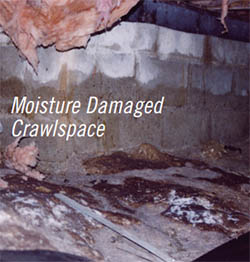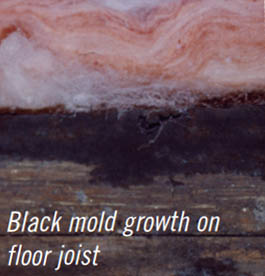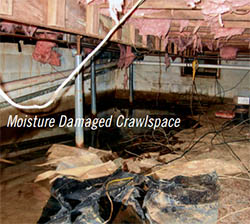Understanding the Crawlspace

Excess moisture will result in mold growth on floor joists, subflooring and other structural members within the crawlspace. The current solution is to increase ventiliation in the crawlspace. This solution does not work.
Years ago houses were built on high, dry sites allowing for plenty of ventilation underneath. With high and dry sites becoming scarce, builders are resorting to less suitable land. This change in trend has increased the possibly of moisture accumulation in the crawlspace.
If there is moisture in the crawlspace, there is a problem—bottom line. The extent of the problem depends on the amount of moisture, how often the moisture is present, and the proximity of the structural members to the damp area.
Crawlspaces constructed without taking the proper precautionary measures may result in excess moisture. Damp crawlspaces create more than desirable conditions for the growth of mold as well as posing other threats to the home. Venting the crawlspace only increases moisture levels in most cases. Water management is essential for maintaining the integrity and air quality of the structure. Installation of a VaporFree® System will alleviate the problems resulting from improper crawlspace conditions.
“If there is moisture in the crawlspace, there is a problem.”
• Cracks, holes and improper construction of foundation walls
• Rain collecting near the base of the structure
• Outside humidity entering in through crawlspace vents
• Condensation
• And more…
• Rain collecting near the base of the structure
• Outside humidity entering in through crawlspace vents
• Condensation
• And more…

Not only is a wet crawlspace the most common problem, it is the most damaging. If the home has a vented crawlspace, it is likely there is a moisture problem. If unsure about how to evaluate the situation, a VaporFree representative will be glad to discuss your situation.
When Left Unmanaged

Dampness under the wood floor structure of homes that are built on raised foundations can contribute to: Wet conditions which encourage mold, fungi and rot which will damage wood floor joists and girders to the point of failure; many molds that will cause allergic reactions and serious illness; settlement which can be accelerated; electric shock to those who venture in this area which is many times more likely; termites and other unwanted pests which are attracted to the moisture; wood flooring that can warp and twist; just to name a few.

• Poor indoor air quality
• High moisture content
• Microbial activity
• Standing water (90% of building failure is due to moisture)
• Damage to interior woodwork
• Infestation of insects such as spiders, water bugs and termites
• High moisture content
• Microbial activity
• Standing water (90% of building failure is due to moisture)
• Damage to interior woodwork
• Infestation of insects such as spiders, water bugs and termites

